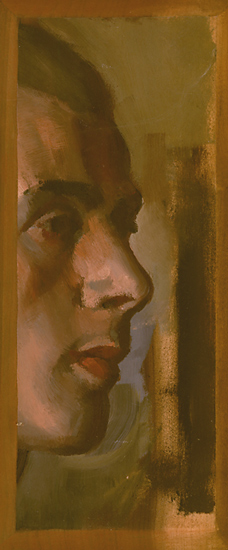
Self Portrait, c.1920
Framed (ref: 5209)
Oil on panel, 11 3/4 x 5 1/8 in. (30 x 13 cm.)
Tags: Victor Hume Moody oil panel men portraits

Tags: Victor Hume Moody oil panel men portraits
Victor Moody’s distinctive voice has yet to find a large, enthusiastic and
appreciative public. He is not alone. He is in good company with other
British artists from the period, whose work is strikingly recognizable and
yet at the same time almost permanently out of vogue: Robert Weir Allen,
Harry Morley, William Strang, Charles Sims, Charles Shannon, Ambrose
McEvoy, Stanley Lewis, Albert Victor Wood. All displayed remarkable
technical skill - grounded in a profound and thorough training in draughtsmanship,
combined with acutely observed narratives. They are infused
with humour and idiosyncrasy. While the skill might be beyond dispute,
the subject matter and composition can make the work inaccessible to
a modern day audience. There is a sense of melodrama, a distortion of
beauty, a heightening of colour which unsettles. Most viewers are drawn
to conclude, sometimes reluctantly, more often readily, that the work produced
by such artists does not merit serious consideration. But what today
is seen, at best, as an enchanted backwater, might well be understood by
future generations to represent a more mainstream current of the art of its
day. The inherent quality of their work and the originality of their vision
begs a reassessment of their individual and collective place in twentieth
century British Art.
All of the works in this catalogue have come from the Estate of Catherine
Moody and represent the most important body of Victor Moody’s oeuvre
to have ever come on the market. We are especially grateful to Stephen
Whittle for the introductory essay to this catalogue. As the culmination of
two decades of research it provides an excellent context for Victor Moody’s
work.
For full information download our catalogue:
/download/LFA_Victor_Moody_catalogue.pdf